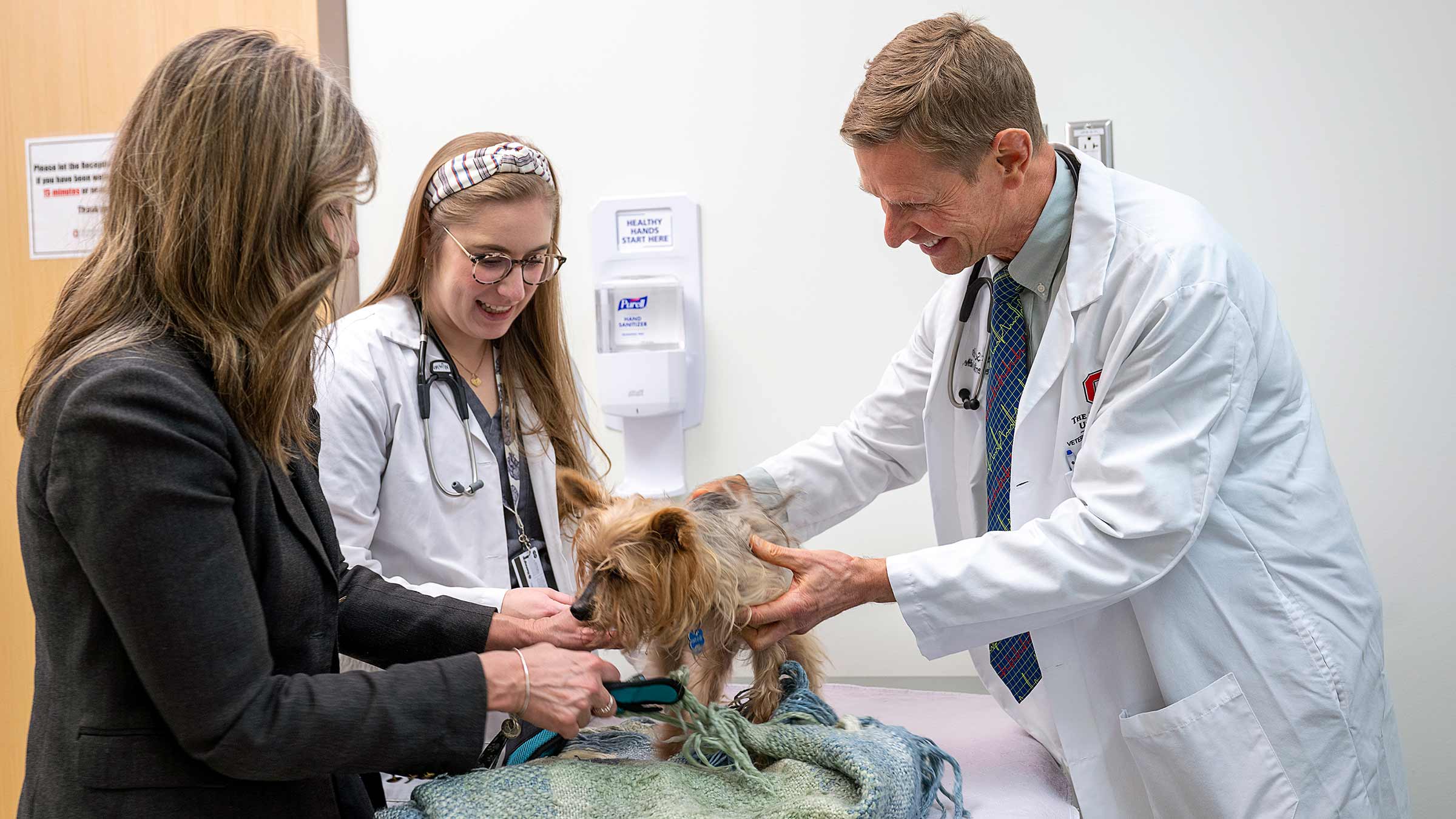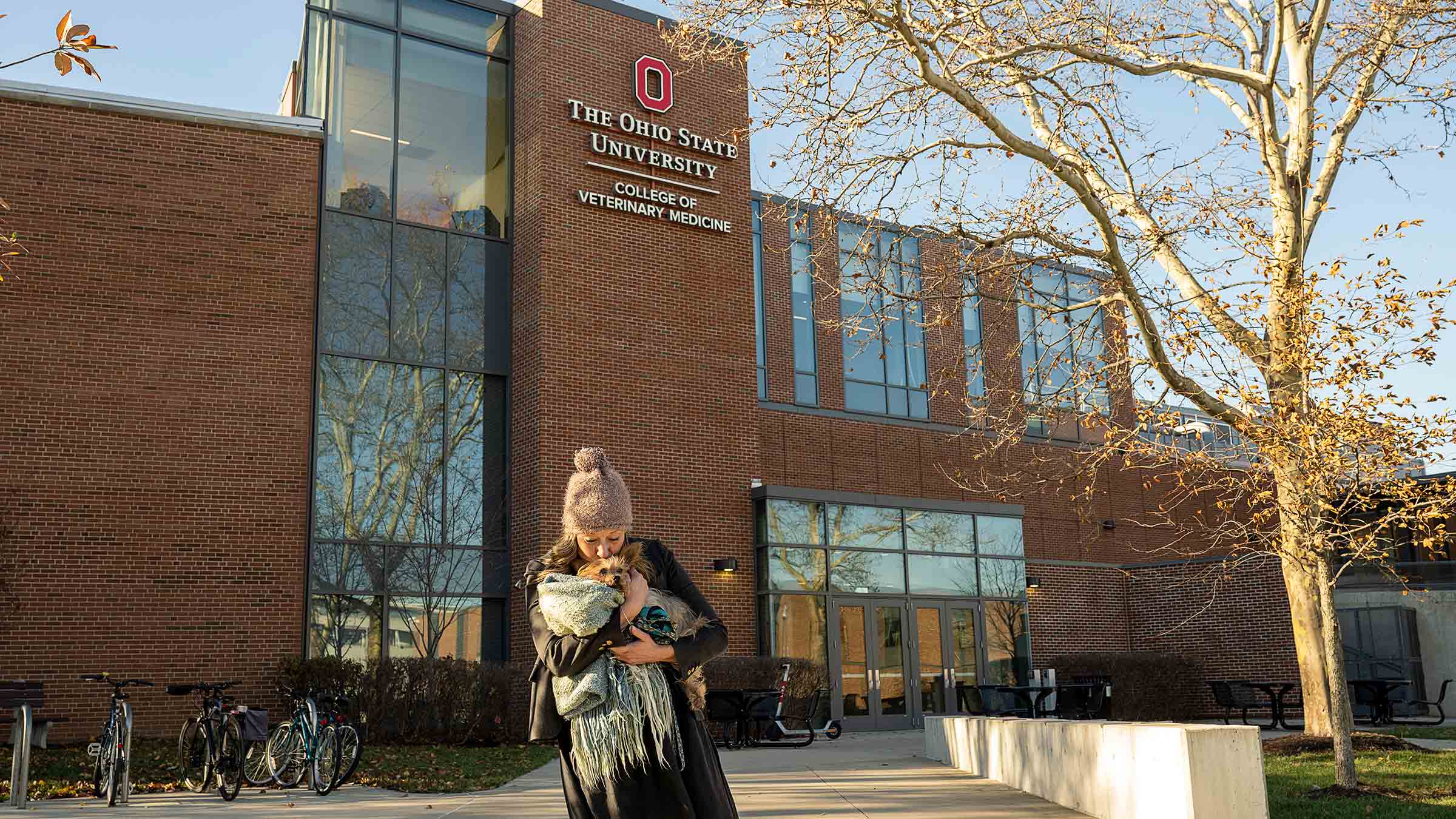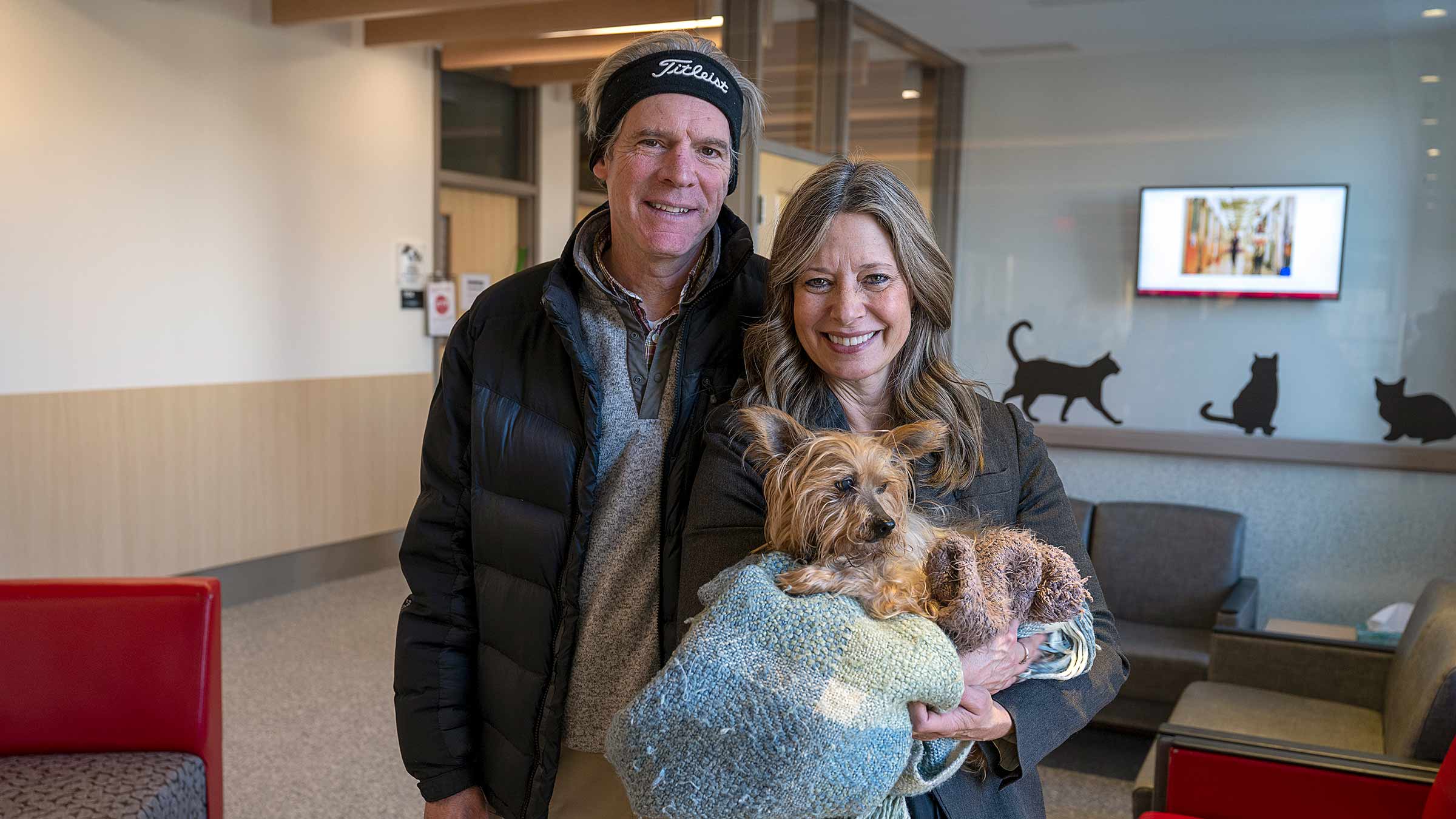Heart disease in dogs: protecting Winnie’s heart
How an Ohio State veterinary team’s fast action led to a successful, individualized treatment for a tiny, 14-year-old terrier — and how to spot heart disease in your own pets.
Winnie had always loved taking long walks around his neighborhood.
But last spring, he started to hesitate as he reached the corner near the end of the block.
Winnie was getting tired. It was time to turn his leash around and head back home.
Looking back, his caretaker, Amy Acton, MD, MPH, realizes it was one of the first signs that Winnie’s heart was starting to give out.
Dr. Acton and her family later learned that the Yorkshire terrier, who’s about 14 years old, had an abnormally fast heart rhythm.
Winnie’s medical journey started when veterinarians had to stop a routine dental cleaning because his heart rate jumped to 320 beats per minute. That’s four times the normal rate of 80 beats per minute for a Yorkie.
A critical time
Winnie was taken to the Emergency and Critical Care Service at The Ohio State University Veterinary Medical Center, where he was hospitalized in the intensive care unit for three days and veterinarians performed several imaging and blood tests.
He received lifesaving round-the-clock care, including IV medications and heart rhythm monitoring, frequent blood pressure measurements and hand feeding, says Karsten Schober, DVM, PhD, the section head of Cardiology and Interventional Medicine at The Ohio State College of Veterinary Medicine.

Winnie went home wearing a monitor in a mini backpack-type bag to keep track of his heartbeats, and Dr. Acton kept a diary of his activity and symptoms.
It was a challenging time. Winnie came into the Acton family when he was a puppy, almost too tiny to stand up under his big ears. He’s since been a friend to all six of the now-grown children in the Actons’ blended family and was the youngest companion to the two rescue dogs they’ve since lost.
“Winnie is the last part of our almost empty nest, so he’s been around and with us for a long time,” says Dr. Acton, the former director of the Ohio Department of Health, who added that her schoolteacher husband, Eric, grew even closer to the terrier during the COVID-19 pandemic.
“Winnie is like family, and I was amazed that the thought of him being sick left me feeling vulnerable.”
Coming up with a plan
During the first two days of Winnie’s stay at Ohio State, nothing seemed to work, says Dr. Schober, who oversees Winnie’s care with Eline Nijveldt, DVM, Cardiology and Interventional Medicine resident.
They had to come up with a different plan.
Winnie was too small for a procedure that uses catheters inside the heart to stop abnormal rhythms, referred to as arrhythmias, so they considered using additional rarely considered human medications. But there was almost no research in the area about their effects on dogs, so they consulted with other experts, one in Dayton, Ohio, and one in Italy.
After some trial and error, watching side effects closely, the doctors found a combination of drugs that helped Winnie get back to his old self.
“Winnie has a very strong will to live,” Dr. Schober says. “He’s now 14 years old, an age that can be translated into more than 100 years old in people. His heart, despite the arrhythmia, looks amazingly good.”

Recognizing heart disease symptoms in dogs and cats
Many pets, like Winnie, suffer from heart disease. And often, there are no symptoms.
More than half of dogs older than 10 years have heart valve disease, a condition that worsens with age and often leads to death, Dr. Schober says. In younger, large dog breeds, heart muscle diseases are relatively common. And 15-30% of cats will develop abnormal thickening of the heart chambers.
Mild to moderate heart disease often shows no signs in dogs and cats. As heart disease becomes advanced, there also may be no symptoms, especially in cats.
When heart disease signs are present, they may include:
- Fast or difficult breathing or coughing
- Difficulty or lack of desire in exercising
- Fatigue, fainting or collapsing
To prevent heart disease in pets, Schober recommends:
- Not breeding animals born with heart disease
- Having a family veterinarian screen pets for heart disease, starting at age 3-4 in dogs and age 2 in cats, with a stethoscope and a blood test
- Avoiding obesity
- Addressing endocrine diseases, such as thyroid dysfunction, diabetes or Cushing’s disease
- Choosing balanced and veterinarian-recommended pet food, keeping in mind that some grain-free dog foods are deficient in necessary nutrients
If found too late, the outcome is often poor. If detected early, treatment can delay symptoms in some animals by several years. Treatments are based primarily on medications, but options also include cardiac implants and, rarely, open-heart surgery and cardiac pacemakers.
If you or your veterinarian suspect heart disease, Dr. Schober says, it’s important to talk to a specialist as soon as possible. Many veterinarians don’t have access to echocardiography imaging of the heart and may have limited experience with heart disease and heart failure.
More time for Winnie
Dr. Acton says Winnie became attached to his caregivers, who had a way of helping him feel comfortable and relaxed despite everything he had to go through.

“You can really see a difference,” says Dr. Acton. “He had lost a lot of weight, he got really, really bony and lethargic. And so, one big difference is he perked up. He can take some walks. He’s more himself. He’s playful. His fur got fluffier. He just seemed healthier.”
Dr. Acton says she’s become enamored with the impressive care team that she and Winnie have gotten to know — from the specialists to the emergency room crew to the primary care group to the veterinary medical students.
Dr. Schober says everyone involved took something away from Winnie’s experience.
“Not all cases end like this,” he says. “We all learned to never give up. Not everyone believed Winnie would leave the hospital alive. But Winnie made it and now is several months out of those critical moments. And of course, the devotion and support by the Acton family was outstanding.”
Dr. Acton is especially grateful for the extra days the family has been given. Twice from home, they’d called hospice, thinking it was Winnie’s time. But it wasn’t, and the Actons have had a few months now when the thought hasn’t even crossed their minds.
“It's hard when they can’t tell you exactly what they're feeling. But he would seem like a pretty ordinary dog now,” Dr. Acton says before bringing Winnie to her lap and accepting a kiss with a smile. “You can see that we’ve grown a bit attached.”







